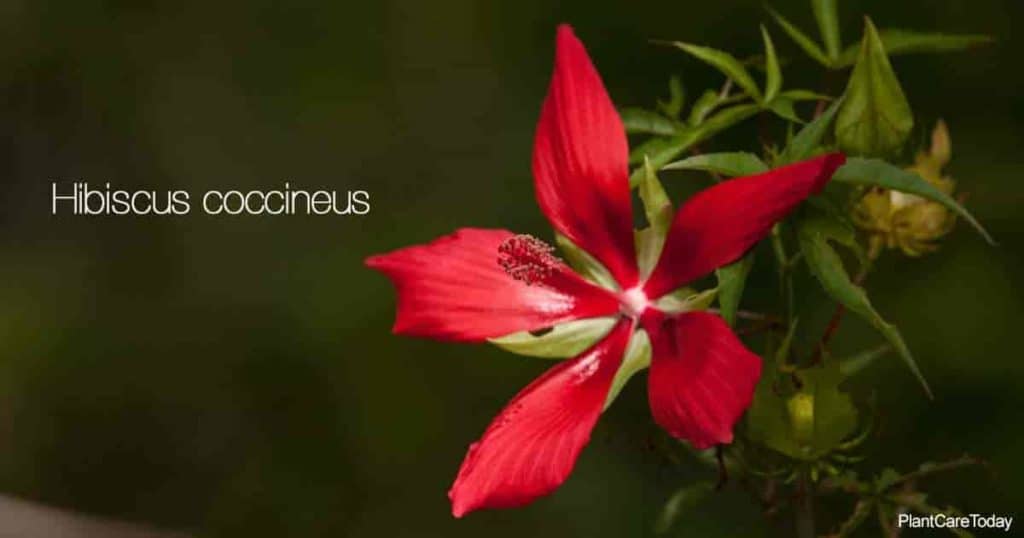Hibiscus coccineus [hi-BIS-kus, kok-SIN-ee-us] is a hardy hibiscus plant with woody stems and foliage resembling Cannabis sativa.

People call H. coccineus one of the following common names:
- Scarlet rose mallow
- Scarlet rosemallow
- Scarlet hibiscus
- Brilliant hibiscus
- Texas star Hibiscus
Despite the common name “Texas Star,” the native plant does not call Texas home.
It’s mostly found throughout the marshes and swamps of the coastal plains in the southeastern United States.
It belongs to the Hibiscus plant genus and the Malvaceae (mallow) family.
Hibiscus Coccineus Care
Size and Growth
Scarlet hibiscus is a hardy, vigorous grower. It produces woody stems, reaching up to 6’ feet tall with a spread of 2’ – 3’ feet.
The leaves are deep green and measure 5″ – 6″ inches long. They are thin and pointed, resembling the foliage of the hemp plant.
Flowering and Fragrance
It’s sometimes a late bloomer with red hibiscus flowers appearing between late June and early September.
Most people grow the plant for its showy flowers, featuring five-petaled flowers with a deep scarlet red color.

The flowers often reach up to 5″ inches, and each one has a center staminal column. The blooms last throughout the summer.
Light and Temperature
Due to the height of the plant, it’s commonly grown outdoors. Grow in full sun to partial shade.
NOTE: While scarlet hibiscus grows in partial shade, too much shade may diminish flowering and cause leggy growth.
It’s winter hardy in USDA hardiness zone 6 or higher.
Hibiscus coccineus grows well in regions with high humidity and hot summers.
In cooler regions, it may survive outdoors over winter with a good cover of winter mulch.
Watering and Feeding
Keep the soil moist during the growing season between spring and late fall.

Mold isn’t a common issue as the plant tolerates high humidity.
In the winter, limit watering but avoid letting the soil completely dry out.
Soil and Transplanting
Grow scarlet hibiscus in wet soil with medium drainage. It grows well in a combination of sand, clay, and loam or near swampy areas.
The plant doesn’t need transplanting unless the gardener chooses to relocate the plant.
Grooming
Most gardeners trim the plant back after flowering cutting the dried stems to the ground in late winter.

The following spring, the stems begin growing rapidly, reaching the full 6’ foot size each year.
How To Propagate Scarlet Hibiscus
Propagate using seed or stem cuttings.
- The plant grows easily from seed, whether harvested from the plant or purchased in packets from a nursery.
- To collect seeds from the plant, allow the flowers to fall naturally without cutting.
- A green seed pod develops at the base of the flower.
- After the seed pod turns brown, use pruning shears to remove the pod.
- Carefully crack open the pod to remove the seeds.
- Store in envelopes until early spring.
- Sow the seeds in starter trays using standard potting soil.
- Keep the soil moist until the seeds germinate.
- For best results, don’t let the seedlings dry out and place them near a window with lots of sunlight.
- After the last threat of frost passes, transplant the young plants to their permanent homes.

To propagate with stem cuttings in the spring, use the following steps:
- Take 5” – 6” inch-long cuttings using a pair of pruning shears.
- Dip the cuttings in rooting hormone.
- Use containers filled with damp peat moss or vermiculite.
- Press the cuttings 3” inches into the soil.
- Place the containers outdoors or indoors but avoid direct sunlight.
When the cuttings start producing new leaves, the plants are ready for transplanting.
Place in the garden or in individual pots.
Scarlet Rose Hibiscus Pest or Diseases
Hibiscus tends to attract butterflies and hummingbirds, which shouldn’t pose a threat to the plant. It’s not invasive or toxic. More about Hibiscus and your dog.
The main issues to worry about include aphids, hibiscus whiteflies, and Japanese beetles.
- Spray cold water on the leaves to get rid of the pests.
- Adding a few drops of dish soap to the water may also work.
- If the pests remain, use an insecticidal soap.

The plant may also suffer from Hibiscus rust, a fungal disease that sometimes affects woody plants.
It’s caused by a fungal parasite and produces rust-colored spots on the leaves.
Remove all infected parts of the plant using pruning shears.
Spray the soil with water to help clear away any debris, especially if grown in the garden around other plants.
If the rust remains, wait until late winter and trim the stems down to the ground.
The following spring, new growth should appear.
Suggested Hibiscus Coccineus Uses
Scarlet hibiscus is a large perennial eventually reaches about 6’ feet tall, making it a good choice for the back border of a garden or courtyard.

In warm, humid regions, consider growing it in moist soil near the edge of a stream or pond.